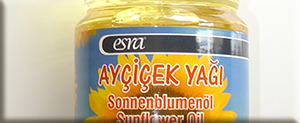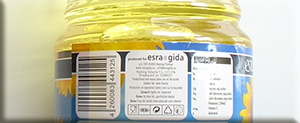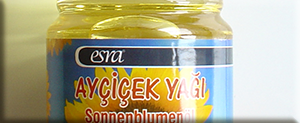About Sunflower Oil
Sunflower oil is produced extracting from the seeds of the Sunflower [Helianthus Annuus] as it is clearly understood from the name. Sunflower is the only plant the seeds of which are grown by tracking the movements of the Sun.
In general, two types of Sunflower Seeds are grown as white with stripes consumed as snack in confectionery and with black stripes for producing oil. 1 Cup of Sunflower kernel is 8 oz as volume, or 4,2 oz as weight.
Seeds of the type for oil are precessed as shown in the summarized scheme below and raw oil is gained.
It is cheaper when compared to olive oil and therefore used in producing bio-diesel production.
Raw oil, later on, refined and winterized, thus freed from smell and foreign matters, clarified and becomes oil for cooking purposes and also its remainder is used as livestock feed.

Although production process is generally the same in standard and specific products, it may reveal some differences depending on timing, quality of raw material, moisture percentage of the product, quality of sub-additives used for purifying, refining and deodorizing and also the output of operation.
As a result of this process, naturally, quality of the product becomes either 1st class or 2nd class.
- Good quality oil has light yellow colour, a special odour and taste.
- It does not contain any foreign matters and must have specifications conforming to the scheme below.
| THE CLASSIFICATION OF THE SUNFLOWER OIL | ||
|---|---|---|
| COMPOSITION | QUALITY VALUES | |
| CLASS | CLASS | |
| Specific Gravity | 0,918-0,923 (20 °C/20°C) | 0,909-0,915 (25°C/20°C ) |
| Refractive Index nD | 1,461-1,468 (40°C) | 1,467-1,471 (25°C) |
| Saponification mg KOH/g | 188-194 | 182-194 |
| Iodine Values | 118-141 | 78-90 |
| Unsaponifiable matters, g/kg, max | 15 | |
| Fatty Composition, % (m/m) (from total methyl ester) | ||
| Lauric acid (C12:0), max | 0,1 | - |
| Myristic acid (C14:0), max | 0,2 | 0,1 |
| Palmitic acid (C16:0) | 5,0-7,6 | 2,6-5,0 |
| Palmitoleic acid (C16:1), max | 0,3 | 0,1 |
| Margaric acid (C17:0), max | 0,2 | 0,1 |
| Heptadecanoic acid (C17:1), max | 0,1 | |
| Stearic acid (C18:0) | 2,7-6,5 | 2,9-6,2 |
| Oleikc acid (C18:1) | 14,0-39,4 | 75-90,7 |
| Linoleic acid (C18:2) | 48,3-74,0 | 2,1-17,0 |
| Linolenic acid (C18:3), max | 0,3 | |
| Arachidic acid (C20:0) | 0,1-0,5 | 0,2-0,5 |
| Gadoleic acid (20:1), max | 0,3 | 0,1-0,5 |
| Behenic acid (C22:0) | 0,5-1,1 | 0,5-1,6 |
| Erucic acid (C22:1), max | 0,3 | |
| (C22:2), max | 0,3 | - |
| Lignoceric acid (C24:0), max | 0,5 | |
| Moisture &volatile, %(m/m), max | 0,2 | |
| Insoluble Impurities, % (m/m), max | 0,05 | |
| Soap Content % (m/m), max | 0,005 | |
| Free Fatty Acid (as oleic ), % (m/m), max | 0,3 | |
| Peroxide Value, O2/kg, max | 10 | |
| Mineral Fat | never | |
| Iron, mg/kg, max | 1,5 | |
| Cupper, mg/kg, max | 0,1 | |
Composition of foods we get necessary for human life contains protein, carbohydrate and fat.
Fats formed ith O, C and H atoms connected to them as chemical composition, both give calories and especially become source of energy for our body.
They ensure A, D, E, K vitamins to be stored in our body and absorbed by being carried in blood circulation and they exist in lipid group. Fat acids are not generated by our body and only taken in with nutrients. Fats are firstly divided into two categories as solid and liquid fats then each one differs into two again as saturated and unsaturated fat acids.
Fats are firstly divided into two categories as solid and liquid fats then each one differs into two again as saturated and unsaturated fat acids.
Within the frame of above fact, cooking sunflower oil is in the category of liquid fats composed by %9-10 saturated and the rest unsaturated fats.
Unsaturated fats acids are called as mono unsaturated fat acids which means Oleic Acid [Omega-9 C18H34O2; C17H33COOH] and multi unsaturated fat acids which means Linoleic Asid [Omega-6 C18H32O2; C17H31COOH] and Linolenic Asid [Omega-3 C18H30O2; C17H29COOH].
Saturated Fat Acids exist as Stearic Acid (which means Saturated Oleic Acid C18H36O2) and Palmitic Acid (C16H32O2).
Sunflower Oils for cooking purposes are subject to a classification depending on production quality, technological method and ratio of oleic and linoleic acids they contain.
For the last thirty years, they have differed into three qualities in respect of their known specifications.
| EDIBLE SUNFLOWER OIL CLASSIFICATION | |||
|---|---|---|---|
| FAT COMPOSITION (%) | PRODUCT TYPES | ||
| POPULAR PRODUCT | NUSUN | HIGH OLEIC SUNFLOWER OIL | |
| Iodine Value | 90-115 | 95-105 | 80-87 |
| Oleic Acid | 14 | 50-75 | 80-82 |
| Linoleic Acid | 75 | 15-35 | 8-9 |
| Linolenic Acid | 0.5-1 | 0.5-1 | Trace |
| Palmitic Acid | 7 | 4-5 | 5 |
| Stearic Acid | 3-4 | 3-4 | 4 |
| Free Fatty Acid | 0.1 | 0.05-1 | 0.05 |
| Odour | 450 | 450 | 450 |
| Taste | Bland | Bland | Bland |
| Colour AOCS Yellow | 25 | 15 | 10 |
| Peroxide Value | 1.0 | 1.0 | 0.5 |
The higher ratio of oleic acid when oil has, it is deemed to be higher quality class in respect of usage, productivity and health.
Oils which contain high ratio of oleic acid are very valuable and mostly used in food production and industry which need particularly mono unsaturated fat acids.
Fats with medium level acid ratio are produced by enriching low oleic acid cooking sunflower oil with standard hybrid process.
That sort of oils give nice taste in frying since Linoleic acid ratio of them is around %25.
That kind of sunflower oil also contain rich vitamins (Vitamin-E, Folic acid (Vitamin-B9), Thiamine (Vitamin-B-1), Niacin, Minerals, (Iron, Riboflavin, Calcium, Phosphor, Potassium, Sodium), Carbohydrates and Proteins).
Fot that reason, liquid oils which are rich in unsaturated fat acids should be preferred for heart and vessel health. Cacao oil, palm oil, palm seed oil which contain saturated and also trans fat acids-even-weak- should be avoided even they are liquid. Sunflower, canola, soy or corn oil which have rich unsaturated fat acids should be preferred and when buying oil, the ratio of saturated and unsaturated fats indicated on label should be taken into consideration.
Doubtlessly, during their production, countries are attentive for these features within the frame of standards, bu in spite of this fact, the products of many countries and firms has not been able to gain the international standard yet.
Links
Our firm, as representative, has been exporting this product which has international standard and specifications.
Sunflower oil products







You're here: Homepage > Products > Oil Based Products > Sunflower oil products




